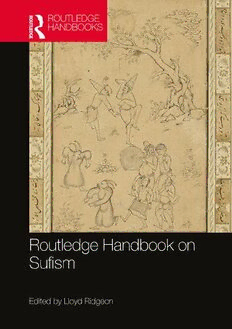
Routledge handbook on Sufism PDF
Preview Routledge handbook on Sufism
ROUTLEDGE HANDBOOK ON SUFISM This is a chronological history of the Sufi tradition, divided into three sections, early, middle and modern periods. The book comprises 35 independent chapters with easily identifiable themes and/or geographical threads, all written by recognised experts in the field. The volume outlines the origins and early developments of Sufism by assessing the forma- tive thinkers and practitioners and investigating specific pietistic themes. The middle period contains an examination of the emergence of the Sufi Orders and illustrates the diversity of the tradition. This middle period also analyses the fate of Sufism during the time of the Gunpowder Empires. Finally, the third period includes representative surveys of Sufism in several countries, both in the West and in traditional “Islamic” regions. This comprehensive and up-to-date collection of studies provides a guide to the Sufi tradition. The Handbook is a valuable resource for students and researchers with an interest in religion, Islamic Studies and Middle Eastern Studies. Lloyd Ridgeon is reader in Islamic Studies at Glasgow University. His main research inter- ests include Persianate Sufism and also Iranian history and modern Iranian culture. He has published extensively on areas including javānmardī, and he is currently writing a book on how the ḥijāb has been understood by modern Iranian seminarians. . Taylor & Francis ( Taylor & Francis Group http://taylorandfrancis.com ROUTLEDGE HANDBOOK ON SUFISM Edited by Lloyd Ridgeon First published 2021 by Routledge 2 Park Square, Milton Park, Abingdon, Oxon OX14 4RN and by Routledge 52 Vanderbilt Avenue, New York, NY 10017 Routledge is an imprint of the Taylor & Francis Group, an informa business © 2021 selection and editorial matter, Lloyd Ridgeon; individual chapters, the contributors The right of Lloyd Ridgeon to be identified as the author of the editorial material, and of the authors for their individual chapters, has been asserted in accordance with sections 77 and 78 of the Copyright, Designs and Patents Act 1988. All rights reserved. No part of this book may be reprinted or reproduced or utilised in any form or by any electronic, mechanical, or other means, now known or hereafter invented, including photocopying and recording, or in any information storage or retrieval system, without permission in writing from the publishers. Trademark notice: Product or corporate names may be trademarks or registered trademarks, and are used only for identification and explanation without intent to infringe. British Library Cataloguing-in-Publication Data A catalogue record for this book is available from the British Library Library of Congress Cataloging-in-Publication Data Names: Ridgeon, Lloyd V. J., editor. Title: Routledge handbook on Sufism / edited by Llyod Ridgeon. Description: New York: Routledge, 2020. | Includes bibliographical references and index. Identifiers: LCCN 2020010674 | ISBN 9781138040120 (hardback) | ISBN 9781315175348 (ebook) | ISBN 9781351706483 (adobe pdf) | ISBN 9781351706476 (epub) | ISBN 9781351706469 (mobi) Subjects: LCSH: Sufism—History. | Mysticism—Islam—History. Classification: LCC BP188.5 .R68 2020 | DDC 297.4—dc23 LC record available at https://lccn.loc.gov/2020010674 ISBN: 978-1-138-04012-0 (hbk) ISBN: 978-1-315-17534-8 (ebk) Typeset in Bembo by codeMantra For my family, and Rusty, a faithful and loyal companion on the path. . Taylor & Francis ( Taylor & Francis Group http://taylorandfrancis.com CONTENTS List of illustrations xi List of contributors xiii Transliteration xviii Preface xix PART ONE The early period 1 1 The origins of Sufism 3 Lloyd Ridgeon 2 al-Ḥārith al-Muḥāsibī and spiritual purification between asceticism and mysticism 17 Gavin N. Picken 3 al-Junayd al-Baghdādī: Chief of the Sect 32 Erik S. Ohlander 4 Abū Yazīd al-Bisṭāmī and discussions about intoxicated Sufism 46 Annabel Keeler 5 Al-Ghazālī: in praise of Sufism 63 Carole Hillenbrand 6 ‘Ayn al-Quḍāt’s Qur’anic vision: from black words to white parchment 75 Mohammed Rustom vii Contents 7 Ibn ‘Arabi and the Akbarī tradition 89 Jawad Anwar Qureshi 8 Jalāl al-Dīn Rūmī and his place in the history of Sufism 103 Ibrahim Gamard 9 Opposition to Sufis in the formative period 120 Harith Ramli 10 Narrativizing early mystic and Sufi women: mechanisms of gendering in Sufi hagiographies 132 Sara Abdel-Latif 11 Sufism and travelling 146 Arin Salamah-Qudsi 12 Sufism and Qur’ānic ethics 159 Atif Khalil 13 Love and beauty in Sufism 172 Joseph E. B. Lumbard 14 Sufism in classical Persian poetry 187 Ali-Asghar Seyed-Gohrab PART TWO The middle period 201 15 Sufi orders in the medieval period 203 Lloyd Ridgeon 16 The Bektaşiyya: the formative period, 1250–1516 217 Riza Yildirim 17 The Chishtiyya 233 Scott Kugle 18 The Qalandariyya: from the mosque to the ruin in poetry, place, and practice 252 Katherine Pratt Ewing and Ilona Gerbakher 19 The Shādhiliyya: foundational teachings and practices 269 Lahouari Ramzi Taleb viii Contents 20 Sufism, tombs and convents 283 Thierry Zarcone 21 Clothing and investiture in medieval Sufism 316 Eyad Abuali 22 Sufism and Christian mysticism: the neoplatonic factor 330 Saeed Zarrabi-Zadeh 23 The Jewish-Sufi encounter in the Middle Ages 343 Elisha Russ-Fishbane 24 Sufism and the Hindu dharma 358 Thomas Dähnhardt 25 Sufism and the Safavids in Iran: a further challenge to “Decline” 370 Andrew J. Newman 26 The Mughals and Sufism 387 Kashshaf Ghani 27 Sufism in the Ottoman Empire 399 John J. Curry 28 The Qāḍīzādelis and Sufism 418 Mustapha Sheikh PART THREE The modern period 433 29 Sufism in modern Turkey 435 Kim Shively 30 Sufism in the UK 449 Ron Geaves 31 Sufism and vernacular knowledge in Sindh 461 Michel Boivin 32 A Sufism for our time: the Egyptian society for spiritual and cultural research 474 Valerie J. Hoffman 33 Sufism in modern Morocco 487 Marta Dominguez Diaz ix
